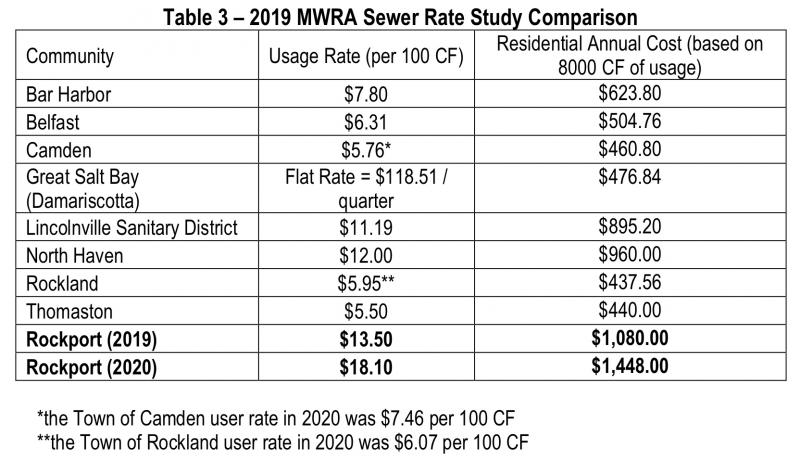Members of the Rockport Select Board were recently presented with a number of options for how and where the municipality’s wastewater is processed in the future, ranging from maintaining existing intermunicipal agreements with neighboring communities to building two new wastewater treatment facilities in town.
Nate McLaughlin, a principal at Saco-based firm Woodard & Curran (W&C) outlined five options for the board at its April 26 meeting. W&C had been hired by the Select Board in February to conduct a $10,000 study which included performing a sewer user charge/flow appropriation calculation, within which the firm would review the the rate structure pertaining to the interlocal agreements with Camden and Rockland.
Through the study, parcels of land were to be identified upon which a wastewater treatment facility could be built, and a “lifecycle” cost analysis would be provided for the existing technology, pipes, and 20 pumping stations in Rockport.
McLaughlin began the presentation by outlining the usage rates in 2020 for wastewater, as well as the debt service rates over the year.
In 2020, the fee per 100 cubic feet of wastewater was $18.10, up more than $4 from the previous year’s rate of $13.50.
The town’s annual debt service rose to $274 from $247 in 2019.
He put the hike in wastewater costs into greater perspective by comparing Rockport’s wastewater fees to those in neighboring towns; Rockport has significantly higher fees than any town or city in the area including island communities which typically would have the highest wastewater service costs associated with them.
In 2019, when processing 100 cubic feet of wastewater cost $13.50 in Rockport, the same amount of water was processed in Camden for $5.76, in Rockland for $5.95 and on the island of North Haven for $12.00.
“The study was in essence looking at the very high [fee] level, the feasibility of constructing your own treatment facility or treatment facilities, and handling wastewater treatment and collection within the community and not relying on the interlocal municipal agreements you have currently with your neighbors,” said McLaughlin on April 26.
McLaughlin presented five options, the first being the “do nothing” option of maintaining the existing interlocal agreements with Camden and Rockland through which Rockport’s wastewater is send to the neighboring location for treatments.
Other options would be to build one wastewater treatment plant somewhere within Rockport Village and maintain the processing agreement with Rockland;
to build two treatment facilities, one in Rockport Village and one in the Glen Cove area;
to build one plant in the Rockport Village area and manage all collection flow; and,
to build one plant in the village and to send any remaining flow to Rockland.
Currently, on a daily basis, Rockport is sending approximately 160,000 cubic feet of wastewater to Camden and 180,000 cubic feet to Rockland for processing.
Anticipating where a new wastewater processing plant could be built in Rockport, W&C’s study focused on town-owned parcels of land, and how readily they could be equipped with ingoing and outgoing pipes and connected to the existing sewer system.
The sites for new facilities used for schematic purposes included the former Rockport Elementary School (RES) site on West St., and a parcel of property in Glen Cove at the north end of an existing picnic area along Route 1.
McLaughlin said a new treatment plant typically occupies about an acre of land. Neither construction costs for a new treatment facility nor operating costs were discussed during the meeting or included in the information packet for the meeting.
“We see [the RES site] as the ‘welcoming spot’ to Rockport, it’s entering a portion of Rockport –the village– and we see that as some of the most valuable property we have so obviously we want to use it for property that brings value to the town and certainly no sewer treatment plant,” said Chair Debra Hall.
“At some point in time, in the very near future, we need to be looking at our agreement with Camden again. So any adjustment in numbers that we can give them and documentation will help us with the billing on their end. Is that something on the agenda for us to be doing,” Select Board member Mark Kelley asked Town Manager Bill Post.
“I think you’ll learn much more when we get to the executive session,” said Post. Shortly thereafter the board entered an executive session and the public portion of the meeting ended.
“The Select Board consulted with its attorney for legal advice on certain matters in the executive session. The Select Board does not have a position yet on the wastewater options,” said Hall on April 27.
In February, the Select Board approved a $5.8 million sewer extension project which would extend the town’s sewer line from Sea Light Lane to South Street. The town received three bids for the project, and selected low bidder Nitram Excavation and General Contractor, Inc. of Benton, to perform the work for $5,846,748.
Referred to as the Route 1 Wastewater Project, the scope of work Nitram Excavation will be performing includes laying approximately 8,000 linear feet of gravity sewer line, 7,400 linear feet of sewer force main and 6,400 linear feet of water main. The project includes construction of two new wastewater pump stations.























